Anti-inflammatory food superstars for every season
- Reviewed by Howard E. LeWine, MD, Chief Medical Editor, Harvard Health Publishing; Editorial Advisory Board Member, Harvard Health Publishing

Berries and watermelon in the summer, kale and beets in the winter. The recipe for anti-inflammatory foods to enjoy can change with the seasons.
Your heart, your brain, and even your joints can benefit from a steady diet of these nutritious foods, and scientists think that their effects on inflammation may be one reason why.
Inflammation: How it helps and harms the body
Inflammation is part of your body's healing mechanism — the reason why your knee swelled and turned red when you injured it. But this inflammatory repair process can sometimes go awry, lasting too long and harming instead of helping. When inflammation is caused by an ongoing problem, it can contribute to health problems. Over time, inflammation stemming from chronic stress, obesity, or an autoimmune disorder may potentially trigger conditions such as arthritis, heart disease, or cancer. It may also harm the brain. Researchers have found a link between higher levels of inflammation inside the brain and an elevated risk for cognitive decline and impairment. Regularly adding anti-inflammatory foods to your diet may help to switch off this process.
Three diets that emphasize anti-inflammatory patterns
Research hasn't looked specifically at the anti-inflammatory benefits of eating foods that are in season. "But it's generally accepted that eating what's in season is likely to be fresher and obviously there are other benefits, including those for the environment," says Natalie McCormick, a research fellow in medicine at Harvard Medical School. Eating foods that are in season may also help your grocery bill.
When it comes to anti-inflammatory foods, the goal should be to incorporate as many as you can into your overall diet. "Our emphasis now is on eating patterns, because it seems that interactions between foods and their combinations have a greater effect than individual foods," says McCormick.
Three diets in particular, she says, contain the right mix of elements: The Mediterranean diet, the DASH diet, and the Alternative Healthy Eating Index. These diets are similar in that they put the emphasis on foods that are also known to be anti-inflammatory, such as colorful fruits and vegetables, whole grains, legumes, and healthy fats such as olive oil and nut butters. But just as importantly, these diets also eliminate foods — such as highly processed snacks, red meat, and sugary drinks — that can increase levels of inflammatory markers inside the body, including a substance called C-reactive protein.
Mixing and matching different foods from these diets can help you tailor an anti-inflammatory approach that fits your personal tastes, as can choosing the freshest in-season offerings. Whole grains, legumes, and heart-healthy oils can be year-round staples, but mix and match your fruits and vegetables for more variety. Below are some great options by season.
Winter anti-inflammatory superstars
In the cold winter months, think green. Many green leafy vegetables star during this season, including kale, collard greens, and swiss chard. Root vegetables like beets are another great and hardy winter option. Reach for sweet potatoes and turnips. Other options to try are kiwi fruit, brussels sprouts, lemons, oranges, and pineapple.
Spring anti-inflammatory superstars
When the spring months arrive, look for asparagus, apricots, avocados, rhubarb, carrots, mushrooms, and celery, as well as fresh herbs.
Summer anti-inflammatory superstars
Summer is prime time for many types of produce, and you'll have lots of choices. Berries are a great anti-inflammatory option. Try different varieties of blueberries, blackberries, and strawberries. Go local with marionberries, huckleberries, gooseberries, and cloud berries, which grow in different parts of the US. Also reach for cherries, eggplant, zucchini, watermelon, green beans, honeydew melon, okra, peaches, and plums.
Fall anti-inflammatory superstars
Nothing says fall like a crisp, crunchy apple. But there are a host of other anti-inflammatory foods to try as well, such as cabbage, cauliflower, garlic, winter squash, parsnips, peas, ginger, and all types of lettuce.
Whenever possible, when you choose an anti-inflammatory food try to substitute it for a less healthy option. For example, trade a muffin for a fresh-berry fruit salad, or a plate of French fries for a baked sweet potato. Making small trades in your diet can add up to big health benefits over time.
About the Author

Kelly Bilodeau, Former Executive Editor, Harvard Women's Health Watch
About the Reviewer

Howard E. LeWine, MD, Chief Medical Editor, Harvard Health Publishing; Editorial Advisory Board Member, Harvard Health Publishing
Disclaimer:
As a service to our readers, Harvard Health Publishing provides access to our library of archived content. Please note the date of last review or update on all articles.
No content on this site, regardless of date, should ever be used as a substitute for direct medical advice from your doctor or other qualified clinician.
















